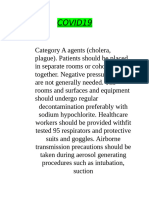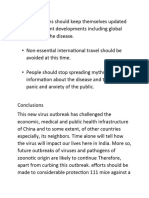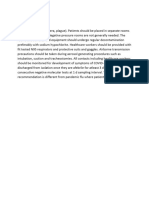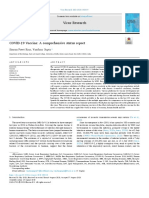0 ratings0% found this document useful (0 votes)
65 viewsTRANSLATED
TRANSLATED
Uploaded by
JamieAkhmadThe document discusses how monoclonal antibodies (MAbs) targeting the receptor binding domain (RBD) of the SARS-CoV-2 spike protein show potential as a treatment for COVID-19, as cross-neutralizing SARS-CoV RBD-specific MAbs have shown effectiveness against related coronaviruses. Appropriate RBD-specific MAbs could be identified by analyzing the similarity between the RBD of SARS-CoV-2 and SARS-CoV. Combination therapy with RBD-targeting MAbs and the drug remdesivir may provide an ideal treatment option for COVID-19.
Copyright:
© All Rights Reserved
Available Formats
Download as PDF, TXT or read online from Scribd
TRANSLATED
TRANSLATED
Uploaded by
JamieAkhmad0 ratings0% found this document useful (0 votes)
65 views4 pagesThe document discusses how monoclonal antibodies (MAbs) targeting the receptor binding domain (RBD) of the SARS-CoV-2 spike protein show potential as a treatment for COVID-19, as cross-neutralizing SARS-CoV RBD-specific MAbs have shown effectiveness against related coronaviruses. Appropriate RBD-specific MAbs could be identified by analyzing the similarity between the RBD of SARS-CoV-2 and SARS-CoV. Combination therapy with RBD-targeting MAbs and the drug remdesivir may provide an ideal treatment option for COVID-19.
Copyright
© © All Rights Reserved
Available Formats
PDF, TXT or read online from Scribd
Share this document
Did you find this document useful?
Is this content inappropriate?
The document discusses how monoclonal antibodies (MAbs) targeting the receptor binding domain (RBD) of the SARS-CoV-2 spike protein show potential as a treatment for COVID-19, as cross-neutralizing SARS-CoV RBD-specific MAbs have shown effectiveness against related coronaviruses. Appropriate RBD-specific MAbs could be identified by analyzing the similarity between the RBD of SARS-CoV-2 and SARS-CoV. Combination therapy with RBD-targeting MAbs and the drug remdesivir may provide an ideal treatment option for COVID-19.
Copyright:
© All Rights Reserved
Available Formats
Download as PDF, TXT or read online from Scribd
Download as pdf or txt
0 ratings0% found this document useful (0 votes)
65 views4 pagesTRANSLATED
TRANSLATED
Uploaded by
JamieAkhmadThe document discusses how monoclonal antibodies (MAbs) targeting the receptor binding domain (RBD) of the SARS-CoV-2 spike protein show potential as a treatment for COVID-19, as cross-neutralizing SARS-CoV RBD-specific MAbs have shown effectiveness against related coronaviruses. Appropriate RBD-specific MAbs could be identified by analyzing the similarity between the RBD of SARS-CoV-2 and SARS-CoV. Combination therapy with RBD-targeting MAbs and the drug remdesivir may provide an ideal treatment option for COVID-19.
Copyright:
© All Rights Reserved
Available Formats
Download as PDF, TXT or read online from Scribd
Download as pdf or txt
You are on page 1of 4
category A agents (cholera, plague).
Patients should be placed in separate
rooms or cohorted together. Negative
pressure rooms are not generally
needed. The rooms and surfaces and
equipment should undergo regular
decontamination preferably with
sodium hypochlorite. Healthcare
workers should be provided with fit
tested N95 respirators and protective
suits and goggles. Airborne
transmission precautions should be
taken during aerosol generating
procedures such as intubation, suction
and tracheostomies. All contacts
including healthcare workers should
be monitored for development of
symptoms of COVID-19. Patients can be
discharged from isolation once they
are afebrile for at least 3d and have
two consecutive negative molecular
tests at 1 d sampling interval. This
recommendation is different from
pandemic flu where patients were
• All clinicians should keep
themselves updated about recent
developments including global
spread of the disease.
• Non-essential international travel
should be avoided at this time.
• People should stop spreading
myths and false information about
the disease and try to allay panic
and anxiety of the public.
Conclusions
This new virus outbreak has
challenged the economic, medical and
public health infrastructure of China
and to some extent, of other countries
especially, its neighbors. Time alone
will tell how the virus will impact our
lives here in India. More so, future
outbreaks of viruses and pathogens of
zoonotic origin are likely to continue.
Therefore, apart from curbing this
outbreak. efforts should he made to
considerable protection in mice against a MERS-
CoV lethal challenge. Such antibodies may play a
crucial role in enhancing protective humoral
responses against the emerging CoVs by aiming
appropriate epitopes and functions of the S protein.
The cross-neutralization ability of SARS-CoV RBD-
specific neutralizing MAbs considerably relies on
the resemblance between their RBDs, therefore,
SARS-CoV RBD-specific antibodies could cross-
neutralized SL CovVs, i.e., bat-SL-CoV strain WIVI1
(RBD with eight amino acid differences from SARS-
CoV) but not bat-SL-CoV strain SHC014 (24 amino
acid differences) (200).
Appropriate RBD-specifie MAbs can be
recognized by a relative analysis of RBD of SARS-
CoV-2 to that of SARS-COV, and cross-neutralizing
SARS-CoV RBD-specific MAbs could be explored
for their effectiveness against COVID-19 and further
need to be assessed clinically, The U.S.
biotechnology company Regeneron is attempting to
recognize potent and specific MAbs to combat
COVID-19. An ideal therapeutic option suggested
for SARS-CoV-2 (COVID-19) is the combination
therapy comprised of MAbs and the drug remdesivir
(COVID-19) (201). The SARS-CoV-specific human
MAb CR3022 is found to bind with SARS-CoV-2
RBD, indicating its potential as a therapeutic agent
You might also like
- Risk Assessment Example 1Document3 pagesRisk Assessment Example 1miptahul100% (3)
- Typology of Nursing Problems in Family Nursing PracticeDocument2 pagesTypology of Nursing Problems in Family Nursing PracticeHarlene Joyce Rey100% (3)
- Covid 19Document51 pagesCovid 19Engr AhmedNo ratings yet
- Family NCP For HazardDocument3 pagesFamily NCP For HazardAfia TawiahNo ratings yet
- ASADocument3 pagesASAMelisa Malik75% (4)
- CopyworkpdfDocument124 pagesCopyworkpdflccm2312No ratings yet
- Covid 19Document99 pagesCovid 19saadoztr123No ratings yet
- Project 200 Pages WordDocument3 pagesProject 200 Pages WordAndrea PinedaNo ratings yet
- Category A Agents 11Document31 pagesCategory A Agents 11Us ShortaNo ratings yet
- WholeDocument3 pagesWholePQ TODANo ratings yet
- Upwork 1Document118 pagesUpwork 1Yellow MellowNo ratings yet
- Patrick Shaw WorkDocument32 pagesPatrick Shaw WorkRudra GuptaNo ratings yet
- UntitledDocument82 pagesUntitled乙骨憂太No ratings yet
- 6f780b7d7a674d98a91f192975b3eb1f(3)Document75 pages6f780b7d7a674d98a91f192975b3eb1f(3)Taha KhanNo ratings yet
- sampleDocument4 pagessamplesabirhusenailtNo ratings yet
- Wallae FileDocument41 pagesWallae Fileranya chertiouaNo ratings yet
- PROJETDocument4 pagesPROJETLéon RasolonjatovoNo ratings yet
- Libro 1Document50 pagesLibro 1Josafat GomezNo ratings yet
- workDocument13 pagesworksabirhusenailtNo ratings yet
- Davis ProjectDocument76 pagesDavis ProjectMuhammad SameerNo ratings yet
- 1Document79 pages1Umar Ali RajaNo ratings yet
- Can Nanotechnology Help in The Fight Against COVID 19Document17 pagesCan Nanotechnology Help in The Fight Against COVID 19Kishore PaknikarNo ratings yet
- Work 1Document22 pagesWork 1khanlmnoNo ratings yet
- Document 001Document370 pagesDocument 001hi.bizbayNo ratings yet
- Corona Virus 2Document4 pagesCorona Virus 2Anshu VermaNo ratings yet
- 9 In vitro inactivation of SARS‐CoV‐2 by commonly used disinfection products and methodsDocument9 pages9 In vitro inactivation of SARS‐CoV‐2 by commonly used disinfection products and methodsduongthithaianNo ratings yet
- Factors Affecting SARS CoV 2 (COVID-19) PandemicDocument32 pagesFactors Affecting SARS CoV 2 (COVID-19) PandemicTahir AliNo ratings yet
- 30 39Document10 pages30 39Helena Putri SiraitNo ratings yet
- Efficacy of Nitazoxanide in Reducing The Viral Load in COVID-19Document17 pagesEfficacy of Nitazoxanide in Reducing The Viral Load in COVID-19Vinicius BlumNo ratings yet
- MainDocument13 pagesMainIkmah FauzanNo ratings yet
- Khuliso 2Document116 pagesKhuliso 2khulisomadega44No ratings yet
- Immunoglobulins or Convalescent Plasma To Tackle Covid 19 Buying Time To Save Lives - Current and PerspectivesDocument2 pagesImmunoglobulins or Convalescent Plasma To Tackle Covid 19 Buying Time To Save Lives - Current and PerspectivesDaniel PratamaNo ratings yet
- Virus Research: Simran Preet Kaur, Vandana GuptaDocument12 pagesVirus Research: Simran Preet Kaur, Vandana Guptasabila radliyatanNo ratings yet
- UntitledDocument26 pagesUntitledLaura SanchezNo ratings yet
- Work 4Document22 pagesWork 4khanlmnoNo ratings yet
- Sars-Cov-2: Immune Response Elicited by Infection and Development of Vaccines and TreatmentsDocument19 pagesSars-Cov-2: Immune Response Elicited by Infection and Development of Vaccines and TreatmentschaterinaNo ratings yet
- Covid 19Document15 pagesCovid 19Zubair GhouriNo ratings yet
- PIIS0003999320302951Document3 pagesPIIS0003999320302951Adiel CarrascoNo ratings yet
- Knowing When and How To Fight: COVID-19 Between Viral Clearance and Immune ToleranceDocument11 pagesKnowing When and How To Fight: COVID-19 Between Viral Clearance and Immune ToleranceAri Trianto WibowoNo ratings yet
- Covid 19 PDFDocument25 pagesCovid 19 PDFRaihandi PutraNo ratings yet
- Recommendations For The Prevention, Mitigation and Containment of The Emerging Sars-Cov-2 (Covid-19) Pandemic in Haemodialysis CentresDocument5 pagesRecommendations For The Prevention, Mitigation and Containment of The Emerging Sars-Cov-2 (Covid-19) Pandemic in Haemodialysis CentresBastian AgungNo ratings yet
- Covid-19 AddendumDocument10 pagesCovid-19 AddendumPrecious Bardon-MempinNo ratings yet
- Bioactive Natural Compounds Against Human Coronavirus - 2020 - Acta PharmaceuticDocument12 pagesBioactive Natural Compounds Against Human Coronavirus - 2020 - Acta PharmaceuticMohammed Shuaib AhmedNo ratings yet
- Antibodies, Immunity, and COVID-19: Widespread AvailabilityDocument2 pagesAntibodies, Immunity, and COVID-19: Widespread AvailabilityJackson Dias RochaNo ratings yet
- Perspectives On Monoclonal Antibody Therapy As Potential Therapeutic Intervention For Coronavirus Disease-19 (COVID-19)Document9 pagesPerspectives On Monoclonal Antibody Therapy As Potential Therapeutic Intervention For Coronavirus Disease-19 (COVID-19)Juan Gonzalez RoblesNo ratings yet
- Corona Virus 2019Document11 pagesCorona Virus 2019Jonille EchevarriaNo ratings yet
- Untitled Document (1) HDocument4 pagesUntitled Document (1) Hmanishkumarroy823No ratings yet
- Seroprevalence of anti-SARS-CoV-2 Antibodies in COVID-19 Patients and Healthy Volunteers Up To 6 Months Post Disease OnsetDocument16 pagesSeroprevalence of anti-SARS-CoV-2 Antibodies in COVID-19 Patients and Healthy Volunteers Up To 6 Months Post Disease OnsetamyNo ratings yet
- Gao Et Al. 2020 - Chemistry and Biology of SARS-CoV-2Document13 pagesGao Et Al. 2020 - Chemistry and Biology of SARS-CoV-2TSA KishoreNo ratings yet
- Covid 19: Dennis N. Muñoz, RN, RM, LPTDocument103 pagesCovid 19: Dennis N. Muñoz, RN, RM, LPTDennis Nabor Muñoz, RN,RMNo ratings yet
- Sars-Cov-2 Seroconversion in Humans: A Detailed Protocol For A Serological Assay, Antigen Production, and Test SetupDocument15 pagesSars-Cov-2 Seroconversion in Humans: A Detailed Protocol For A Serological Assay, Antigen Production, and Test SetupAKNTAI002No ratings yet
- MICROBIOLOGY PresentationDocument18 pagesMICROBIOLOGY PresentationNavya ThalathotiNo ratings yet
- COVID-19 Fact Sheet ENGDocument32 pagesCOVID-19 Fact Sheet ENGjuancvlNo ratings yet
- New Tele BoomDocument20 pagesNew Tele BoomPAULO SALANDANANNo ratings yet
- Therapeutic Approaches Against Coronaviruses Acute Respiratory SyndromeDocument21 pagesTherapeutic Approaches Against Coronaviruses Acute Respiratory Syndromenow youloseNo ratings yet
- 2020 Troeltzschbrothers Covid-19 EngDocument6 pages2020 Troeltzschbrothers Covid-19 Engdamsia-1No ratings yet
- Cellular and Molecular ImmunologyDocument21 pagesCellular and Molecular ImmunologyMUGDHA MITTALNo ratings yet
- VirusDocument51 pagesVirusBatool SherbiniNo ratings yet
- Corona VirusDocument6 pagesCorona VirusAhmed El ashmawyNo ratings yet
- Antiviral Nucleosides-Flu Viruses-Quinolines-COVID-19: Corresponding AuthorDocument12 pagesAntiviral Nucleosides-Flu Viruses-Quinolines-COVID-19: Corresponding AuthorDrkrishnasarma pathyNo ratings yet
- Covid 19: Rajni SharmaDocument33 pagesCovid 19: Rajni SharmaJuan CruzNo ratings yet
- HCQ Study JamaDocument7 pagesHCQ Study Jamathe kingfishNo ratings yet
- P1Document18 pagesP1siddharthpal275No ratings yet
- CV & File Selva Anggraini - CompressedDocument7 pagesCV & File Selva Anggraini - CompressedJamieAkhmadNo ratings yet
- CV Hermani BambangDocument1 pageCV Hermani BambangJamieAkhmadNo ratings yet
- Form Penlaian Englsih RegularDocument1 pageForm Penlaian Englsih RegularJamieAkhmadNo ratings yet
- Welcome To:: Japanese ClassDocument127 pagesWelcome To:: Japanese ClassJamieAkhmadNo ratings yet
- Pat Gasal Kls X - 17-18 - WajibDocument7 pagesPat Gasal Kls X - 17-18 - WajibJamieAkhmadNo ratings yet
- Affirmative Negative AgreementDocument10 pagesAffirmative Negative AgreementJamieAkhmadNo ratings yet
- Market Selection WD Smart Binary Bot V4: Running Bot Stop BotDocument2 pagesMarket Selection WD Smart Binary Bot V4: Running Bot Stop BotJamieAkhmadNo ratings yet
- The Chainsmokers - CloserDocument2 pagesThe Chainsmokers - CloserJamieAkhmadNo ratings yet
- Expression of Satisfaction and DissatisfactionDocument44 pagesExpression of Satisfaction and DissatisfactionJamieAkhmadNo ratings yet
- In National Di Saster: The Role of The VeterinarianDocument19 pagesIn National Di Saster: The Role of The VeterinarianShafakatNo ratings yet
- Breast Cancer PathophysiologyDocument17 pagesBreast Cancer PathophysiologySwit Tapican MaangNo ratings yet
- Pengelolaan HipertensiDocument7 pagesPengelolaan HipertensiSUPARJO SKep NsNo ratings yet
- Q2 Module 5Document3 pagesQ2 Module 5Primo100% (2)
- Pone.0217968 PLUS IDI-KII-FGD GUIDESDocument18 pagesPone.0217968 PLUS IDI-KII-FGD GUIDESAPRADHANNo ratings yet
- Collection of Specimen For Urine CultureDocument24 pagesCollection of Specimen For Urine Culturenagalakshmi.k krishnappaNo ratings yet
- Selina Concise Biology Solutions Class 9 Chapter 17 Aids To HealthDocument5 pagesSelina Concise Biology Solutions Class 9 Chapter 17 Aids To HealthSiri ChandanaNo ratings yet
- Growth Chart ExampleDocument1 pageGrowth Chart ExampleMawj MandwieNo ratings yet
- Post Abortal CareDocument14 pagesPost Abortal CareRanyang Akafa100% (1)
- References Supporting Testimony of Dr. Christina Parks For Michigan Bill HB4471Document4 pagesReferences Supporting Testimony of Dr. Christina Parks For Michigan Bill HB4471Tim BrownNo ratings yet
- 492 1507 1 SMDocument37 pages492 1507 1 SMmuhammad bramantyoNo ratings yet
- Philippine NLE Board ExamDocument39 pagesPhilippine NLE Board ExamLloyd MelanaNo ratings yet
- Biodigester Drdo Dec 2012Document52 pagesBiodigester Drdo Dec 2012sandeepanchoudhuryNo ratings yet
- Full Download Essentials of Environmental Epidemiology for Health Protection A handbook for field professionals 1st Edition Irene A. Kreis PDF DOCXDocument81 pagesFull Download Essentials of Environmental Epidemiology for Health Protection A handbook for field professionals 1st Edition Irene A. Kreis PDF DOCXremmamomid100% (4)
- Discursive Essay Model Analysis: Task 1. Read The IELTS Writing Task Below. Then Order The Sentences To Make A CompleteDocument6 pagesDiscursive Essay Model Analysis: Task 1. Read The IELTS Writing Task Below. Then Order The Sentences To Make A CompleteNgoc YenNo ratings yet
- Hand, F Oot and Mouth Disease (HFMD)Document8 pagesHand, F Oot and Mouth Disease (HFMD)kukuhpaigeNo ratings yet
- The Philippines in World of PandemicDocument18 pagesThe Philippines in World of PandemicDon QuixoteNo ratings yet
- Misconceptions Surrounding VaccinesDocument1 pageMisconceptions Surrounding Vaccinesjenna milanNo ratings yet
- LRTI An Emerging Future Aspect in Public HealthDocument4 pagesLRTI An Emerging Future Aspect in Public HealthInternational Journal of Innovative Science and Research TechnologyNo ratings yet
- HES007 Lab Session #9 SASDocument14 pagesHES007 Lab Session #9 SASJoan SinutoNo ratings yet
- Hepatitis Test Solutions: DiasinoDocument4 pagesHepatitis Test Solutions: DiasinoAbdalazeez AlsayedNo ratings yet
- Update On DiarrheaDocument12 pagesUpdate On DiarrheantnquynhproNo ratings yet
- Phage TherapyDocument6 pagesPhage Therapyapi-535086280No ratings yet
- 2020 06 16 Bulletin-Brochure Rev 01 PagesDocument120 pages2020 06 16 Bulletin-Brochure Rev 01 PagesTaj MartinNo ratings yet
- Last Leaf QuizDocument1 pageLast Leaf Quizpenaredondo.joy.engchi.northNo ratings yet
- Laundry TrainingDocument40 pagesLaundry TrainingAsia_BilalNo ratings yet


































































































